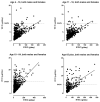Vitamin D Serum Levels in the UK Population, including a Mathematical Approach to Evaluate the Impact of Vitamin D Fortified Ready-to-Eat Breakfast Cereals: Application of the NDNS Database
- PMID: 32585847
- PMCID: PMC7353432
- DOI: 10.3390/nu12061868
Vitamin D Serum Levels in the UK Population, including a Mathematical Approach to Evaluate the Impact of Vitamin D Fortified Ready-to-Eat Breakfast Cereals: Application of the NDNS Database
Abstract
Vitamin D status is relatively poor in the general population, potentially leading to various conditions. The present study evaluates the relationship between vitamin D status and intake in the UK population and the impact of vitamin D fortified ready-to-eat cereals (RTEC) on this status via data from the National Diet and Nutrition Survey (NDNS: 2008-2012). Four cohorts were addressed: ages 4-10 (n = 803), ages 11-18 (n = 884), ages 19-64 (n = 1655) and ages 65 and higher (n = 428). The impact of fortification by 4.2 μg vitamin D per 100 g of RTEC on vitamin D intake and status was mathematically modelled. Average vitamin D daily intake was age-dependent, ranging from ~2.6 (age range 4-18 years) to ~5.0 μg (older than 64 years). Average 25(OH)D concentration ranged from 43 to 51 nmol/L, the highest in children. The relationship between vitamin D intake and status followed an asymptotic curve with a predicted plateau concentration ranging from 52 in children to 83 nmol/L in elderly. The fortification model showed that serum concentrations increased with ~1.0 in children to ~6.5 nmol/L in the elderly. This study revealed that vitamin D intake in the UK population is low with 25(OH)D concentrations being suboptimal for general health. Fortification of breakfast cereals can contribute to improve overall vitamin D status.
Keywords: National Diet and Nutrition Survey; breakfast cereals; vitamin D; vitamin D fortification; vitamin D intake and status.
Conflict of interest statement
The authors declare no conflict of interest. The funders had no role in the design of the study; In the collection, analyses, or interpretation of data; in the writing of the manuscript, or in the decision to publish the results.
Figures


Similar articles
-
Modeling Vitamin D Fortification Scenarios for the Australian Population.J Nutr. 2025 Mar;155(3):890-898. doi: 10.1016/j.tjnut.2024.12.032. Epub 2025 Jan 3. J Nutr. 2025. PMID: 39756682
-
Does fortification of staple foods improve vitamin D intakes and status of groups at risk of deficiency? A United Kingdom modeling study.Am J Clin Nutr. 2015 Aug;102(2):338-44. doi: 10.3945/ajcn.115.107409. Epub 2015 Jul 1. Am J Clin Nutr. 2015. PMID: 26135347
-
Vitamin D intake in Australian adults and the modeled effects of milk and breakfast cereal fortification.Nutrition. 2013 Jul-Aug;29(7-8):1048-53. doi: 10.1016/j.nut.2013.02.011. Nutrition. 2013. PMID: 23759266
-
The impact of voluntary food fortification on micronutrient intakes and status in European countries: a review.Proc Nutr Soc. 2013 Nov;72(4):433-40. doi: 10.1017/S002966511300339X. Epub 2013 Sep 11. Proc Nutr Soc. 2013. PMID: 24020749 Review.
-
Vitamin D Fortification of Fluid Milk Products and Their Contribution to Vitamin D Intake and Vitamin D Status in Observational Studies-A Review.Nutrients. 2018 Aug 9;10(8):1054. doi: 10.3390/nu10081054. Nutrients. 2018. PMID: 30096919 Free PMC article. Review.
Cited by
-
Evaluation of the safety, tolerability and plasma vitamin D response to long-term use of patented transdermal vitamin D patches in healthy adults: a randomised parallel pilot study.BMJ Nutr Prev Health. 2022 Jul 27;5(2):217-226. doi: 10.1136/bmjnph-2022-000471. eCollection 2022 Dec. BMJ Nutr Prev Health. 2022. PMID: 36619342 Free PMC article.
-
The Impact and Efficacy of Vitamin D Fortification.Nutrients. 2024 Dec 14;16(24):4322. doi: 10.3390/nu16244322. Nutrients. 2024. PMID: 39770943 Free PMC article. Review.
-
Vitamin D Sources, Metabolism, and Deficiency: Available Compounds and Guidelines for Its Treatment.Metabolites. 2021 Apr 20;11(4):255. doi: 10.3390/metabo11040255. Metabolites. 2021. PMID: 33924215 Free PMC article. Review.
-
Micronutrients and the Periodontium: A Narrative Review.Cureus. 2025 Apr 4;17(4):e81694. doi: 10.7759/cureus.81694. eCollection 2025 Apr. Cureus. 2025. PMID: 40190829 Free PMC article. Review.
-
Influence of vitamin D supplementation on immune function of healthy aging people: A pilot randomized controlled trial.Front Nutr. 2022 Nov 1;9:1005786. doi: 10.3389/fnut.2022.1005786. eCollection 2022. Front Nutr. 2022. PMID: 36386950 Free PMC article.
References
-
- SACN Vitamin D and Health. [(accessed on 25 August 2016)]; Available online: https://www.gov.uk/government/groups/scientific-advisory-committee-on-nu....
-
- Henderson L., Irving K., Gregory J., Bates C.J., Prentice A., Perks J., Swan G., Farron M. The National Diet and Nutrition Survey: Adults Aged 19 to 64 Years-Vitamin and Mineral Intake and Urinary Analysis. Office for National Statistics; Newport, UK: 2003.
MeSH terms
Substances
LinkOut - more resources
Full Text Sources
Medical

